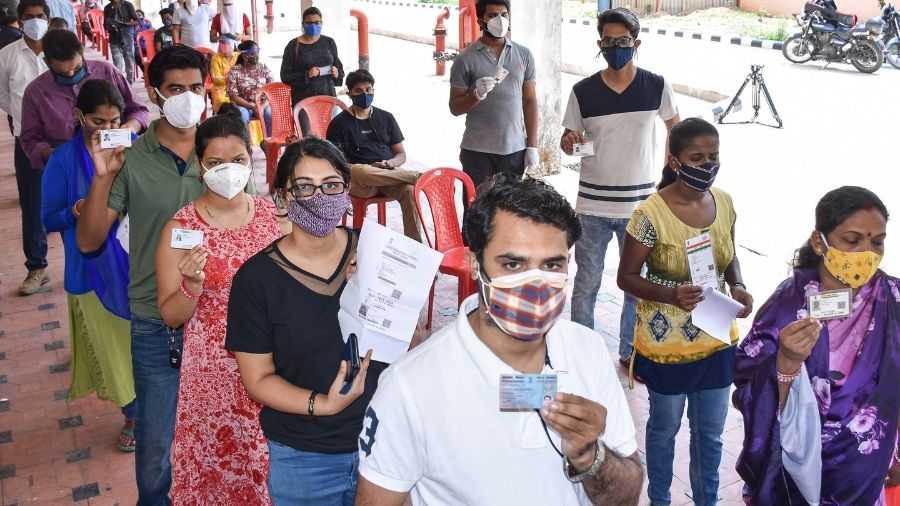India, which is going through a vicious third wave of the Covid-19 pandemic that looks like lasting till July or August, needs to ramp up vaccinations and simultaneously widen its testing network so that those who test positive can be isolated _ thereby allowing some breathing space for health care facilities to regroup.
In an Opinion piece for The New York Times, senior virologist Shaheed Jameel argues that tackling the new variants of the virus should dictate national policy to combat the pandemic. “My observations are that more infectious variants have been spreading, and to mitigate future waves, India should vaccinate with far more than the two million daily doses now,” Jameel, who chairs the Scientific Advisory Group for the Indian SARS-CoV2 Consortium on Genomics, said.
Jameel points out that as of now, India had recorded over 23 million cases of Covid-19 and more than 254,000 deaths, but apprehends the real numbers are much higher since India was reporting on an average more than 380,000 new cases per day.
“All models predict India’s second wave to last until July or August, ending with about 35 million confirmed cases and possibly 500 million estimated infections. That would still leave millions of susceptible people in India. The timing and scale of the third wave would depend on the proportion of vaccinated people, whether newer variants emerge and whether India can avoid additional superspreader events, like large weddings and religious festivals,” he says.
Jameel, who is director of the Trivedi School of Biosciences at Ashoka University, advocates a series of measures to reduce the spread of the virus. He calls for increased testing and isolation of people who test positive. Also, ongoing lockdowns in several states would “flatten the curve,” he says, and allow the health infrastructure to be strengthened.
“Rapidly enhancing the health care infrastructure will also save lives. India should increase available hospital beds by setting up temporary facilities, mobilize retired doctors and nurses, and strengthen the supply chain for critical medicines and oxygen.
“At the same time, India cannot allow the pace of vaccinations to slow. It must vaccinate at scale now, aiming to deliver 7.5 million to 10 million doses every day. This will require enhancing vaccine supplies and doubling delivery points. There are only about 50,000 sites where Indians can get vaccines right now; we need many more.”
Jameel also believes that private hospitals could play a significant role to help ramp up vaccinations. “Since only 3 per cent of these delivery points are in the private sector, this is where capacity can be added.”
The senior virologist says the measures he has outlined had the support of India’s scientific community but that policymakers seemed reluctant to consider the evidence as a basis of planning for the future.
“All of these measures have wide support among my fellow scientists in India. But they are facing stubborn resistance to evidence-based policymaking. On April 30, over 800 Indian scientists appealed to the prime minister, demanding access to the data that could help them further study, predict and curb this virus.
“Decision-making based on data is yet another casualty, as the pandemic in India has spun out of control. The human cost we are enduring will leave a permanent scar,” he writes.
Jameel’s views were published on Friday, less than 24 hours after the Indian government expanded the window of the second dose of the Covishield vaccine _ twice in three months _ leading to criticism that it had been done to make up for the current shortfall in doses.
This even prompted the government to field Niti Aayog member (health) Dr V. K Paul to iterate that the alteration in the vaccine regime was based on science.
“Based on the available real-life evidences, particularly from the UK, the decision to extend it from 6-8 weeks to 12-16 weeks has been taken with confidence that there will not be an extra risk. This is a dynamic decision and, part of periodic review," Paul said.
Jameel is also concerned about not being able to measure the peak cases accurately since testing is slow and inadequate. “Testing is increasing at a far slower rate than cases. In this scenario, numbers will reach a plateau — not because case numbers have stopped rising but because testing capacity will be tapped out. The national average test positivity rate is over 22 per cent, but several states have rates that are, alarmingly, even higher — including Goa at 46.3 per cent and Uttarakhand, which hosted the Kumbh festival, at 36.5 percent.
Vaccines, he says, were the only way out, but current shortages would make it difficult for India to turn the corner. “When the second wave arrived, only 33 million people, about 2.4 per cent of the population, had received one dose and seven million people had received both doses.
“On May 1, vaccination opened for everyone older than 18 years, but many states have reported shortages and the pace of vaccination has slowed down. Local supplies are expected to stabilise by July, but their low penetration cannot reverse the current wave of infection and death in India.”











